Mapping the Transmission of Carbon Emission Responsibility Among Multiple Regions from the Perspective of the Energy Supply Chain: EA-MRIO Method and a Case Study of China
Abstract
1. Introduction
2. Literature Review
3. Materials and Methods
3.1. Modeling Framework for a Multi-Regional Energy Supply Chain
3.2. EA-MRIO Method for Measuring ERCERs
3.2.1. Measurement of ERCERs on Energy-Consumption Side
3.2.2. Measurement of ERCERs on Energy-Production Side
3.3. Case Study and Data Input
4. Results and Discussion
4.1. A Holistic Picture of China’s Multi-Regional ERCER Transmissions in 2017
4.2. Spatial Transmission Analysis of ERCERs
4.3. Discussion on Responsibility Decomposition of Regional Direct Carbon Emission
4.4. Classification of Provinces According to ERCERs Transfer
- (1)
- Category 1: Hubei, Guangdong, and Yunnan. These regions are characterized by a net inflow of ERCERs across all three transport stages since they consistently depend on external sources for both energy and commodities. From another perspective, in economically meeting the final demand of these regions, other provinces effectively shoulder a portion of their direct and embodied ERCERs.
- (2)
- Category 2: Tianjin, Zhejiang, Sichuan, Henan, and Qinghai. Similarly to Category 1, these regions show a net inflow of ERCERs in both energy and economic products transport (i.e., intermediate and final products transport), though not necessarily across all three links.
- (3)
- Category 3: Beijing, Jiangsu, Hainan, Chongqing, Gansu, and Ningxia. These regions demonstrate a net inflow of ERCERs in energy transport, alongside both net inflow and outflow in economic products transport.
- (4)
- Category 4: Fujian, Jiangxi, Hunan, and Guangxi. These regions exhibit a net inflow of ERCERs in energy transport and an approximately balanced flow in economic products transport.
- (5)
- Category 5: Hebei, Shandong, Shanghai, Anhui, Liaoning, and Jilin. These regions show a net inflow of ERCERs in energy transport but a net outflow in economic products transport. In particular, Liaoning and Jilin show a net outflow of ERCERs in both intermediate and final product transport, implying that they undertake a portion of the ERCERs for other regions.
- (6)
- Category 6: Heilongjiang and Xizang. These provinces are characterized by a self-sufficient energy supply and a net inflow of final products.
- (7)
- Category 7: Guizhou, Shanxi, Shaanxi, Xinjiang, and Inner Mongolia. These regions serve as China’s core energy supply bases, with substantial net outflows of ERCERs in intermediate product transport. However, they tend to exhibit net inflows in final product transport, reflecting a structural asymmetry between energy export and consumption-driven imports.
4.5. Implications Under Recent Dual Carbon Policies of China
4.6. Caparision with Existing Research and International Cases
5. Conclusions
- (1)
- Nationally, investment constitutes the largest share of ERCERs in the final demand at 42%, followed by domestic consumption at 34.8% and exports at 23.3%. And the share of ERCERs embodied in investment exceeds 50% in almost all regions. A comprehensive assessment of energy and commodity flows reveals that the ERCERs embodied in China’s exports are broadly equivalent to that embodied in its imports, showing a balance of ERCERs embodied in international trade.
- (2)
- Current policies, whose carbon accounting rely primarily on end-use energy consumption, tend to disproportionately burden energy-producing provinces such as Hebei, Shanxi, and Inner Mongolia. In contrast, when ERCERs are allocated based on final demand, export-oriented provinces such as Guangdong and Jiangsu bear a substantially greater share of the emissions burden.
- (3)
- The spatial transmission pattern of ERCERs is charactered as the flows of ERCERs that originate in North China, initially move toward the eastern coastal regions, and subsequently extend southward, and are finally transferred to foreign countries and to central and western provinces.
- (4)
- Nationally, direct carbon emissions from economic sectors are primarily driven by local demand (73.5%), followed by inter-regional transport (21.1%) and export demand (5.5%). Notably, export-induced emissions are heavily concentrated in eastern coastal provinces, particularly Guangdong, Jiangsu, and Zhejiang.
- (1)
- Adopt a coordinated, demand-oriented approach to ERCERs allocation. Regional carbon emissions are fundamentally driven by economic final demand. Therefore, advancing low-carbon development requires a nationally coordinated strategy that considers the regional division of labor. This entails formulating comprehensive policies for the equitable allocation and regulation of ERCERs across all regions and sectors of the energy–economic system.
- (2)
- Accelerate the development and deployment of non-fossil fuel electricity in eastern provinces. Promoting non-fossil energy usage, especially clean electricity, in the eastern coastal provinces represents one of the most effective pathways for reducing carbon emissions at present.
- (3)
- Focus on industrial energy consumption, particularly coal. Controlling energy consumption within the industrial sector, with particular emphasis on coal usage, should remain a central priority for energy conservation and emission reduction efforts. This is especially critical in regions with coal-intensive heavy industries, such as Hebei, Shanxi, etc.
- (4)
- Mange investment planning in western regions. As infrastructure and capacity expansion continues in western provinces, it is essential to integrate long-term, low-carbon planning into investment strategies. This will help mitigate the risk of excessive carbon emissions associated with fixed capital formation and avoid locking in high-emission trajectories.
Supplementary Materials
Author Contributions
Funding
Institutional Review Board Statement
Informed Consent Statement
Data Availability Statement
Acknowledgments
Conflicts of Interest
Abbreviations
| ERCERs | energy-related carbon emission responsibilities |
| MRIO | multi-regional input-output |
| EA-MRIO | energy allocation induced MRIO |
| EAA | energy allocation analysis |
| EE-MRIO | environmentally extended input-output |
| Mt | million tons |
Appendix A
| Province and Municipality | Abbreviation | Province and Municipality | Abbreviation |
|---|---|---|---|
| Beijing | BJ | Hubei | HB |
| Tianjin | TJ | Hunan | HUN |
| Hebei | HEB | Guangdong | GD |
| Shanxi | SX | Guangxi | GX |
| Inner Mongolia | IM | Hainan | HIN |
| Liaoning | LN | Chongqing | CQ |
| Jilin | JL | Sichuan | SC |
| Heilongjiang | HLJ | Guizhou | GZ |
| Shanghai | SH | Yunnan | YN |
| Jiangsu | JS | Xizang | XZ |
| Zhejiang | ZJ | Shaanxi | SHX |
| Anhui | AH | Gansu | GS |
| Fujian | FJ | Qinghai | QH |
| Jiangxi | JX | Ningxia | NX |
| Shandong | SD | Xinjiang | XJ |
| Henan | HN |
| Integrated Sectors | Original 42 Sectors from MRIO Table |
|---|---|
| Agriculture | S1 Agriculture, Forestry, Animal Husbandry, and Fishery |
| Industry | S2 Mining and washing of coal, S3 Extraction of petroleum and natural gas, S4 Mining and processing of metal ores, S5 Mining and processing of nonmetal and other ores, S6 Food and tobacco processing, S7 Textile industry, S8 Manufacture of leather, fur, feather, and related products, S9 Processing of timber and furniture, S10 Manufacture of paper, printing, and articles for culture, education, and sport activity, S11 Processing of petroleum, coking, and processing of nuclear fuel, S12 Manufacture of chemical products, S13 Manufacture of non-metallic mineral products, S14 Smelting and processing of metals, S15 Manufacture of metal products, S16 Manufacture of general purpose machinery, S17 Manufacture of special purpose machinery, S18 Manufacture of transport equipment, S19 Manufacture of electrical machinery and equipment, S20 Manufacture of communication equipment, computers, and other electronic equipment, S21 Manufacture of measuring instruments, S22 Other manufacturing and waste resources, S23 Repair of metal products, machinery, and equipment, S24 Production and distribution of electric power and heat power, S25 Production and distribution of gas, and S26 Production and distribution of tap water |
| Construction | S27 Construction |
| Traditional services | S28 Wholesale and retail trades, S30 Accommodation and catering |
| Transport services | S29 Transport, storage, and postal services |
| Other services | S31 Information transfer, software, and information technology services, S32 Finance, S33 Real estate, S34 Leasing and commercial services, S35 Scientific research, S36 Polytechnic services, S37 Administration of water, environment, and public facilities, S38 Resident, repair and other services, S39 Education, S40 Health care and social work, S41 Culture, sports, and entertainment, and S42 Public administration, social insurance, and social organizations |
References
- IPCC Climate Change 2023: Synthesis Report. Contribution of Working Groups I, II and III to the Sixth Assessment Report of the Intergovernmental Panel on Climate Change; Core Writing Team, Lee, H., Romero, J., Eds.; IPCC: Geneva, Switzerland, 2023; pp. 35–115. [Google Scholar]
- Institute for Carbon Neutrality Tsinghua University. 2024 Global Carbon Neutrality Annual Progress Report; Institute for Carbon Neutrality, Tsinghua University: Beijing, China, 2024; pp. 3–45. [Google Scholar]
- Institute for Carbon Neutrality Tsinghua University. 2023 Global Carbon Neutrality Annual Progress Report; Institute for Carbon Neutrality, Tsinghua University: Beijing, China, 2023; pp. 5–49. [Google Scholar]
- Zhou, C.; Xiang, X.; Zhu, B.; Wang, Z. Mapping carbon reduction: A cross-continental study of alliance strategies. iScience 2024, 27, 109412. [Google Scholar] [CrossRef]
- Tan, F.; Yang, J.; Zhou, C. Historical review and synthesis of global carbon neutrality research: A bibliometric analysis based on R-tool. J. Clean. Prod. 2024, 449, 141574. [Google Scholar] [CrossRef]
- Kang, J.; Wei, Y.; Liu, L.; Han, R.; Yu, B.; Wang, J. Energy systems for climate change mitigation: A systematic review. Appl. Energ. 2020, 263, 114602. [Google Scholar] [CrossRef]
- Yang, X.; Wang, Z.; Zhang, Y.; Niu, M. Empirical study of China’s provincial carbon emission responsibility allotment: Credit or penalty? Environ. Sci. Pollut. Res. 2020, 27, 40512–40524. [Google Scholar] [CrossRef] [PubMed]
- Yang, D.; Guo, R.; O'Connor, P.; Zhou, T.; Zhang, S.; Meng, H.; Wan, M.; Dai, C.; Ma, W. Embodied carbon transfers and employment-economic spillover effects in China’s inter-provincial trade. Front. Environ. Sci. 2023, 11. [Google Scholar] [CrossRef]
- Zhao, N.; Xu, L.; Malik, A.; Song, X.; Wang, Y. Inter-provincial trade driving energy consumption in China. Resour. Conserv. Recycl. 2018, 134, 329–335. [Google Scholar] [CrossRef]
- Xia, Q.; Wu, X.; Wu, S.; Ma, X. Unraveling the effect of domestic and foreign trade on energy use inequality within China. Renew. Sustain. Energy Rev. 2023, 183, 113472. [Google Scholar] [CrossRef]
- Zhai, M.; Huang, G.; Liu, L.; Xu, X.; Guan, Y.; Fu, Y. Revealing environmental inequalities embedded within regional trades. J. Clean. Prod. 2020, 264, 121719. [Google Scholar] [CrossRef]
- Zhou, D.; Zhou, X.; Xu, Q.; Wu, F.; Wang, Q.; Zha, D. Regional embodied carbon emissions and their transfer characteristics in China. Struct. Change Econ. D 2018, 46, 180–193. [Google Scholar] [CrossRef]
- Wang, Z.; Yang, Y.; Wang, B. Carbon footprints and embodied CO2 transfers among provinces in China. Renew. Sustain. Energy Rev. 2018, 82, 1068–1078. [Google Scholar] [CrossRef]
- Zhen, W.; Li, J. The formation and transmission of upstream and downstream sectoral carbon emission responsibilities: Evidence from China. Sustain. Prod. Consum. 2021, 25, 563–576. [Google Scholar] [CrossRef]
- Wang, Z.; Peng, H.; Meng, J.; Zheng, H.; Li, J.; Huo, J.; Chen, Y.; Wen, Q.; Ma, X.; Guan, D. Enormous inter-country inequality of embodied carbon emissions and its driving forces in South America. Glob. Environ. Change 2024, 89, 102944. [Google Scholar] [CrossRef]
- Liu, X.; Cifuentes-Faura, J.; Shi, W.; Tian, C. Exploring the Carbon Emission Transfers Pathway to Address the Issue of Sustainable Development: A Multi-Regional Input–Output Perspective. Sustain. Dev. 2025, 33, 5676–5703. [Google Scholar] [CrossRef]
- Song, J.; Hu, X.; Wang, X.; Yuan, W.; Wang, T. The spatial characteristics of embodied carbon emission flow in Chinese provinces: A network-based perspective. Environ. Sci. Pollut. Resour. 2022, 29, 34955–34973. [Google Scholar] [CrossRef] [PubMed]
- Zhang, B.; Qiao, H.; Chen, Z.M.; Chen, B. Growth in embodied energy transfers via China’s domestic trade: Evidence from multi-regional input–output analysis. Appl. Energ. 2016, 184, 1093–1105. [Google Scholar] [CrossRef]
- Murphy, R. What is undermining climate change mitigation? How fossil-fuelled practices challenge low-carbon transitions. Energy Res. Soc. Sci. 2024, 108, 103390. [Google Scholar]
- Chong, C.H.; Gao, Y.; Ma, L.; Li, Z.; Ni, W.; Zhou, X.; Cristiano, S.; Meng, F.; Zhang, W.; Yan, N.; et al. A supply chain allocation method for environmental responsibility based on fossil energy as the anchor for carbon responsibility. J. Clean. Prod. 2023, 416, 137904. [Google Scholar] [CrossRef]
- Chong, C.H.; Tan, W.X.; Ting, Z.J.; Liu, P.; Ma, L.; Li, Z.; Ni, W. The driving factors of energy-related CO2 emission growth in Malaysia: The LMDI decomposition method based on energy allocation analysis. Renew. Sustain. Energy Rev. 2019, 115, 109356. [Google Scholar] [CrossRef]
- Ma, L.; Chong, C.; Zhang, X.; Liu, P.; Li, W.; Li, Z.; Ni, W. LMDI Decomposition of Energy-Related CO2 Emissions Based on Energy and CO2 Allocation Sankey Diagrams: The Method and an Application to China. Sustainability 2018, 10, 344. [Google Scholar] [CrossRef]
- Chong, C.; Liu, P.; Ma, L.; Li, Z.; Ni, W.; Li, X.; Song, S. LMDI decomposition of energy consumption in Guangdong Province, China, based on an energy allocation diagram. Energy 2017, 133, 525–544. [Google Scholar] [CrossRef]
- Chong, C.H.; Zhou, X.; Zhang, Y.; Ma, L.; Bhutta, M.S.; Li, Z.; Ni, W. LMDI decomposition of coal consumption in China based on the energy allocation diagram of coal flows: An. update for 2005–2020 with improved sectoral resolutions. Energy 2023, 285, 129266. [Google Scholar] [CrossRef]
- Zhao, Y.; Ma, L.; Li, Z.; Ni, W. A Calculation and Decomposition Method Embedding Sectoral Energy Structure for Embodied Carbon: A Case Study of China’s 28 Sectors. Sustainability 2022, 14, 2593. [Google Scholar] [CrossRef]
- Zhao, Y.; Kong, G.; Chong, C.H.; Ma, L.; Li, Z.; Ni, W. How to Effectively Control Energy Consumption Growth in China’s 29 Provinces: A Paradigm of Multi-Regional Analysis Based on EAALMDI Method. Sustainability 2021, 13, 1093. [Google Scholar] [CrossRef]
- Heinonen, J.; Ottelin, J.; Guddisardottir, A.K.; Junnila, S. Spatial consumption-based carbon footprints: Two definitions, two different outcomes. Environ. Res. Commun. 2022, 4, 25006. [Google Scholar] [CrossRef]
- Wen, W.; Wang, Q. Re-examining the realization of provincial carbon dioxide emission intensity reduction targets in China from a consumption-based accounting. J. Clean. Prod. 2020, 244, 118488. [Google Scholar] [CrossRef]
- Karakaya, E.; Yilmaz, B.; Alatas, S. How production-based and consumption-based emissions accounting systems change climate policy analysis: The case of CO2 convergence. Environ. Sci. Pollut. Res. 2019, 26, 16682–16694. [Google Scholar] [CrossRef]
- Wang, X.; Tang, X.; Zhang, B.; McLellan, B.C.; Lv, Y. Provincial Carbon Emissions Reduction Allocation Plan in China Based on Consumption Perspective. Sustainability 2018, 10, 1342. [Google Scholar] [CrossRef]
- Xie, R.; Hu, G.; Zhang, Y.; Liu, Y. Provincial transfers of enabled carbon emissions in China: A supply-side perspective. Energ. Policy 2017, 107, 688–697. [Google Scholar] [CrossRef]
- Peters, G.P. From production-based to consumption-based national emission inventories. Ecol. Econ. 2008, 65, 13–23. [Google Scholar] [CrossRef]
- Du, Y.; Liu, H.; Huang, H. Bibliometric Analysis of Research Progress and Trends on Carbon Emission Responsibility Accounting. Sustainability 2024, 16, 3721. [Google Scholar] [CrossRef]
- Chen, W.; Lei, Y.; Feng, K.; Wu, S.; Li, L. Provincial emission accounting for CO2 mitigation in China: Insights from production, consumption and income perspectives. Appl. Energ. 2019, 255, 113754. [Google Scholar] [CrossRef]
- Zhou, H.; Ping, W.; Wang, Y.; Wang, Y.; Liu, K. China’s initial allocation of interprovincial carbon emission rights considering historical carbon transfers: Program design and efficiency evaluation. Ecol. Indic. 2021, 121, 106918. [Google Scholar] [CrossRef]
- Wang, M.; Kuusi, T. Trade flows, carbon leakage, and the EU Emissions Trading System. Energ. Econ. 2024, 134, 107556. [Google Scholar] [CrossRef]
- Bai, H.; Zhang, Y.; Wang, H.; Huang, Y.; Xu, H. A Hybrid Method for Provincial Scale Energy-related Carbon Emission Allocation in China. Environ. Sci. Technol. 2014, 48, 2541–2550. [Google Scholar] [CrossRef]
- Cheng, Y.; Tan, X.; Gu, B.; Huang, C.; Yan, H.; Niu, M. Emphasizing egalitarianism in the allocation of China’s provincial carbon emission allowances. J. Clean. Prod. 2023, 395, 136403. [Google Scholar] [CrossRef]
- Qin, Q.; Liu, Y.; Li, X.; Li, H. A multi-criteria decision analysis model for carbon emission quota allocation in China’s east coastal areas: Efficiency and equity. J. Clean. Prod. 2017, 168, 410–419. [Google Scholar] [CrossRef]
- Zhang, Y. Provincial responsibility for carbon emissions in China under different principles. Energ. Policy 2015, 86, 142–153. [Google Scholar] [CrossRef]
- Zhu, Q.; Xu, C.; Pan, Y.; Wu, J. Identifying critical transmission sectors, paths, and carbon communities for CO2 mitigation in global supply chains. Renew. Sustain. Energy Rev. 2024, 191, 114183. [Google Scholar] [CrossRef]
- Fang, G.; Huang, M.; Zhang, W.; Tian, L. Exploring global embodied carbon emissions transfer network—An analysis based on national responsibility. Technol. Forecast. Soc. 2024, 202, 123284. [Google Scholar] [CrossRef]
- Chen, B.; Li, J.S.; Wu, X.F.; Han, M.Y.; Zeng, L.; Li, Z.; Chen, G.Q. Global energy flows embodied in international trade: A combination of environmentally extended input–output analysis and complex network analysis. Appl. Energ. 2018, 210, 98–107. [Google Scholar] [CrossRef]
- Ju, H.; Zeng, G.; Zhang, S. Inter-provincial flow and influencing factors of agricultural carbon footprint in China and its policy implication. Environ. Impact Asses. 2024, 105, 107419. [Google Scholar] [CrossRef]
- Stadler, K.; Wood, R.; Bulavskaya, T.; Södersten, C.; Simas, M.; Schmidt, S.; Usubiaga, A.; Acosta-Fernández, J.; Kuenen, J.; Bruckner, M.; et al. EXIOBASE 3: Developing a Time Series of Detailed Environmentally Extended Multi-Regional Input-Output Tables. J. Ind. Ecol. 2018, 22, 502–515. [Google Scholar] [CrossRef]
- Yang, H.; Ma, L.; Li, Z. A Method for Analyzing Energy-Related Carbon Emissions and the Structural Changes: A Case Study of China from 2005 to 2015. Energies 2020, 13, 2076. [Google Scholar] [CrossRef]
- Yang, X.; Yang, H.; Arras, M.; Chong, C.H.; Ma, L.; Li, Z. Unveiling the Energy Transition Process of Xinjiang: A Hybrid Approach Integrating Energy Allocation Analysis and a System Dynamics Model. Sustainability 2024, 16, 4704. [Google Scholar] [CrossRef]
- Tukker, A.; Poliakov, E.; Heijungs, R.; Hawkins, T.; Neuwahl, F.; Rueda-Cantuche, J.M.; Giljum, S.; Moll, S.; Oosterhaven, J.; Bouwmeester, M. Towards a global multi-regional environmentally extended input–output database. Ecol. Econ. 2009, 68, 1928–1937. [Google Scholar] [CrossRef]
- Ronald, E.M.; Peter, D.B. Input-Output Analysis: Foundations and Extensions, 2nd ed.; Cambridge University Press: Cambridge, UK, 2009. [Google Scholar]
- National Bureau of Statistics of China China Energy Statistical Yearbook 2018, 1st ed.; China Statistics Press: Beijing, China, 2019; pp. 128–307.
- Li, T.; Liu, P.; Li, Z. A multi-period and multi-regional modeling and optimization approach to energy infrastructure planning at a transient stage: A case study of China. Comput. Chem. Eng. 2020, 133, 106673. [Google Scholar] [CrossRef]
- Li, T.; Li, Z.; Li, W. Scenarios analysis on the cross-region integrating of renewable power based on a long-period cost-optimization power planning model. Renew. Energ. 2020, 156, 851–863. [Google Scholar] [CrossRef]
- Li, T.; Liu, P.; Li, Z. Quantitative relationship between low-carbon pathways and system transition costs based on a multi-period and multi-regional energy infrastructure planning approach: A case study of China. Renew. Sustain. Energy Rev. 2020, 134, 110159. [Google Scholar] [CrossRef]
- China Electricity Council 2018 China Electric Power Yearbook, 1st ed.; China Electric Power Press: Beijing, China, 2018.
- Xing, R.; Luo, Z.; Zhang, W.; Xiong, R.; Jiang, K.; Meng, W.; Meng, J.; Dai, H.; Xue, B.; Shen, H.; et al. Household fuel and direct carbon emission disparity in rural China. Environ. Int. 2024, 185, 108549. [Google Scholar] [CrossRef]
- World Bank Group Exports of Goods and Services (% of GDP)—China. Available online: https://data.worldbank.org/indicator/NE.EXP.GNFS.ZS?locations=CN (accessed on 23 August 2025).
- Zhu, Q.; Xu, C.; Lee, C. Trade-induced carbon-economic inequality within China: Measurement, sources, and determinants. Energ. Econ. 2024, 136, 107731. [Google Scholar] [CrossRef]
- Zhang, W.; Yang, M.; Ge, J.; Wang, G. Inter-provincial embodied carbon emission space and industrial transfer paths in China. PLoS ONE 2024, 19, e0300478. [Google Scholar] [CrossRef]
- Han, M.; Yao, Q.; Lao, J.; Tang, Z.; Liu, W. China’s intra- and inter-national carbon emission transfers by province: A nested network perspective. Sci. China Earth Sci. 2020, 63, 852–864. [Google Scholar] [CrossRef]
- Notice on the Issuance of the List of Large-Scale Wind and Photovoltaic Power Base Construction Projects Focusing on Desert, Gobi, and Arid Regions (First Batch). Available online: https://hbdrc.hebei.gov.cn/tzgl_1235/202309/W020230906816478743683.pdf (accessed on 23 August 2025).
- China’s Total Installed Capacity of Wind and Solar Power Exceeds 1.2 Billion Kilowatts, Fulfilling Its Promise Six Years Ahead of Schedule. Available online: https://www.nea.gov.cn/2024-11/08/c_1310787160.htm (accessed on 23 August 2025).
- Hennequin, T.; Hilbers, J.P.; Wilting, H.C.; Ivanova, O.; Kuenen, J.J.P.; Hauck, M.; van Zelm, R.; Huijbregts, M.A.J. Greenhouse gas footprints of economic sectors at the subnational European scale. J. Clean. Prod. 2025, 514, 145761. [Google Scholar] [CrossRef]
- Caron, J.; Metcalf, G.; Reilly, J. The CO2 Content of Consumption Across US Regions: A Multi-Regional Input-Output (MRIO) Approach. Energ. J. 2017, 38, 1–22. [Google Scholar] [CrossRef]
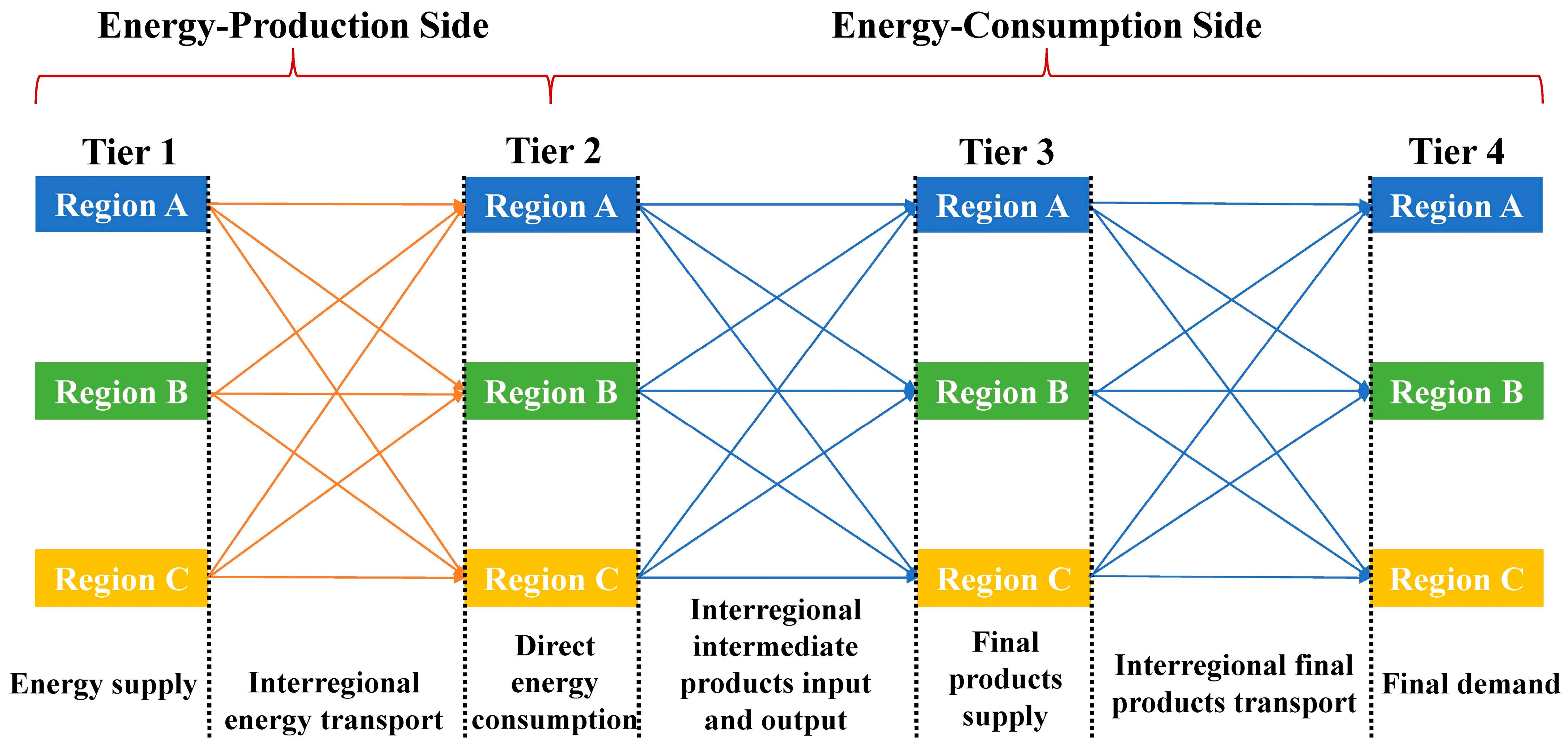
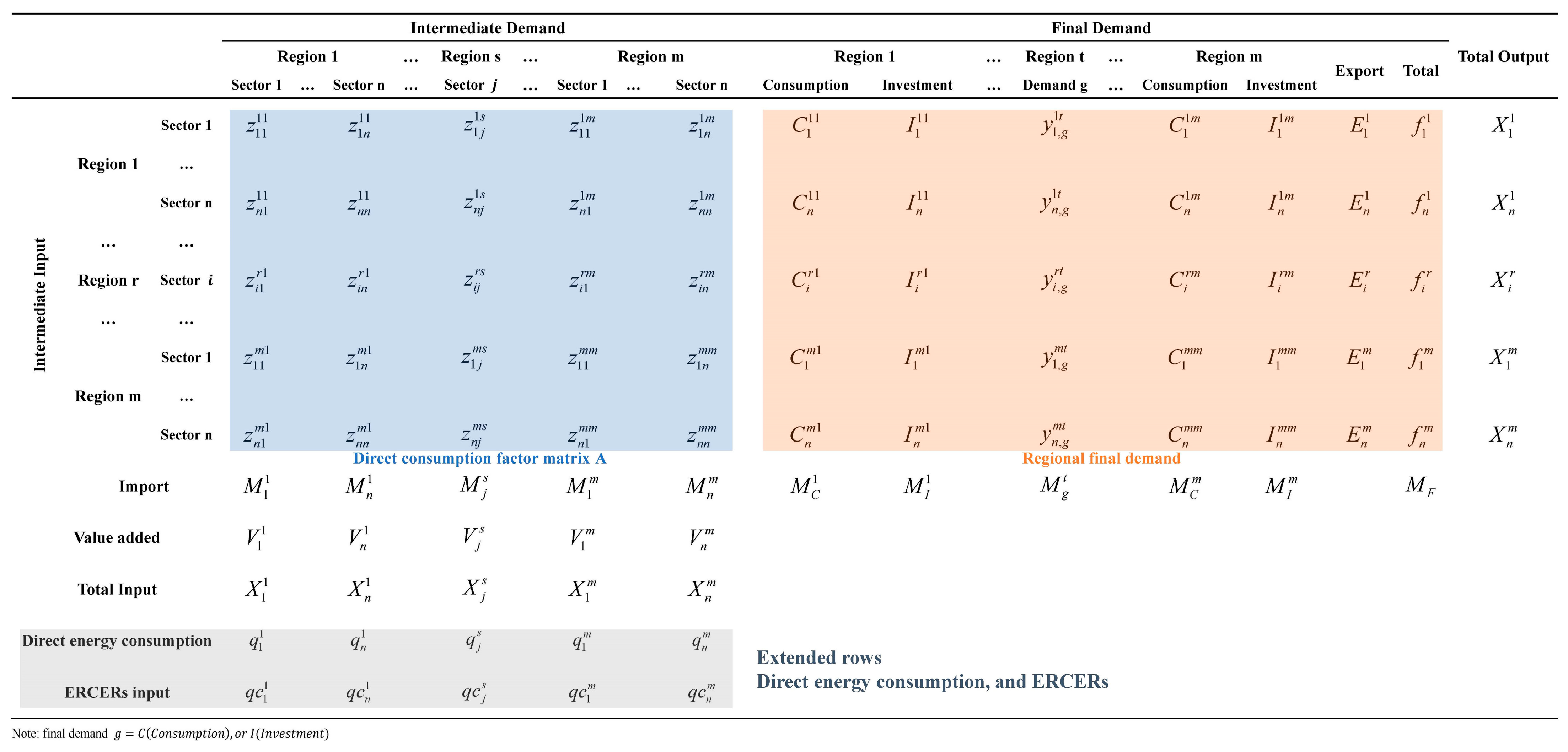
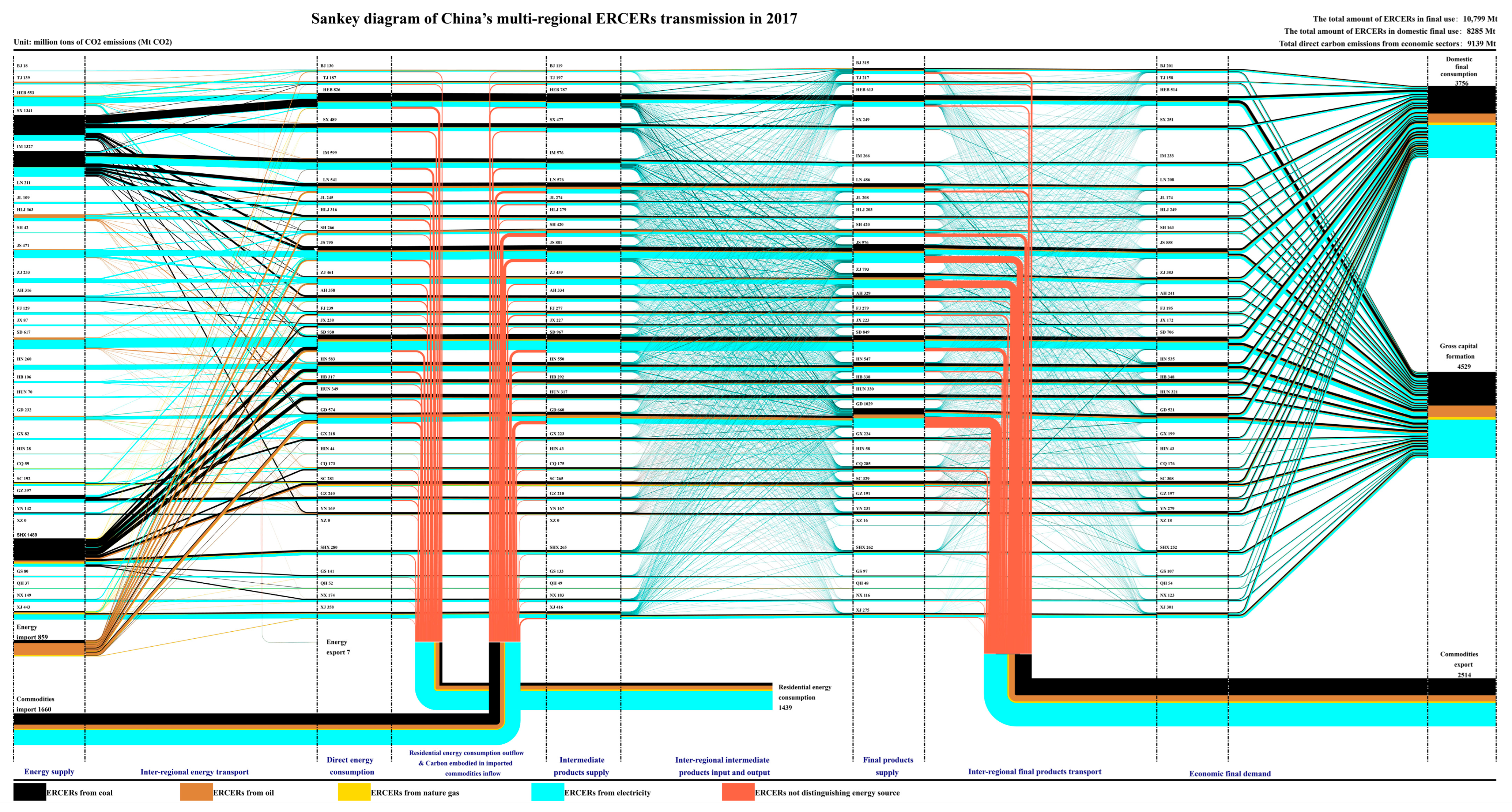
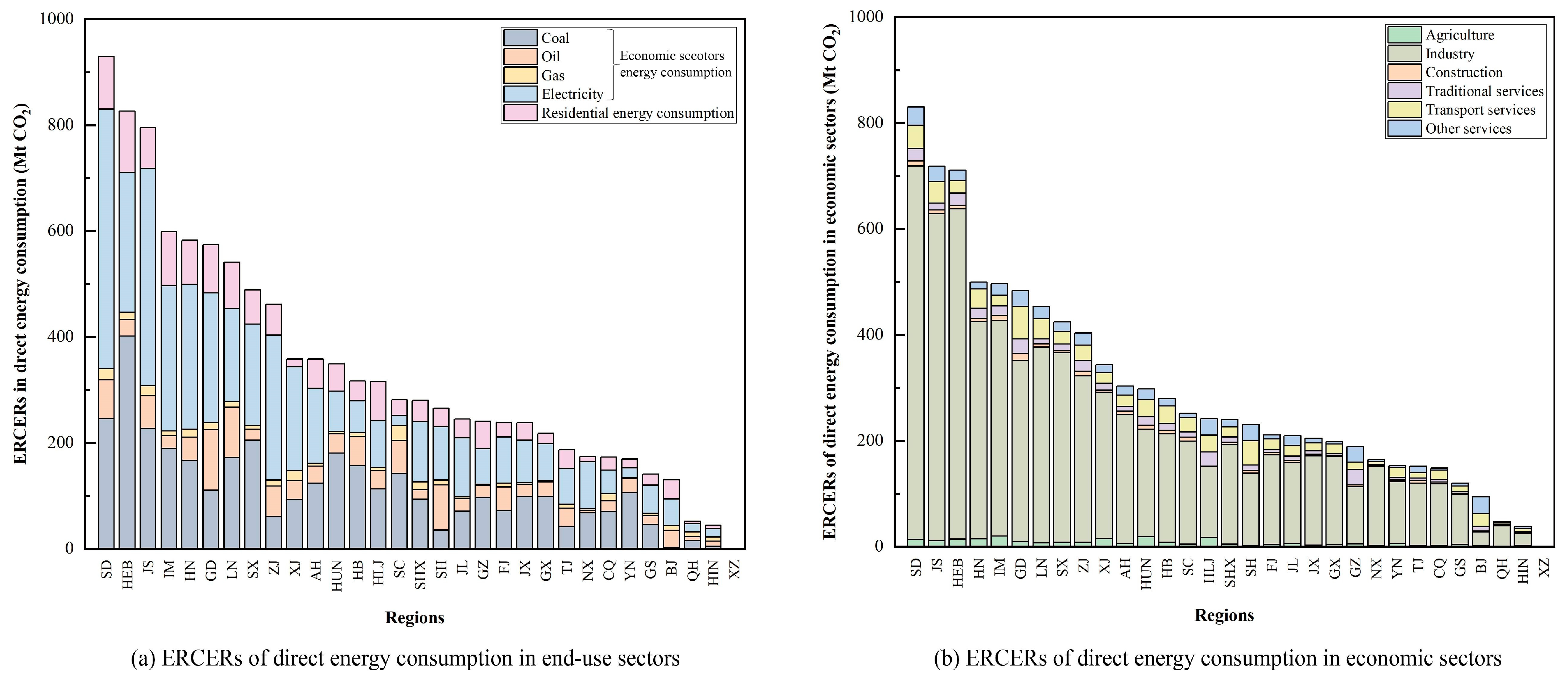
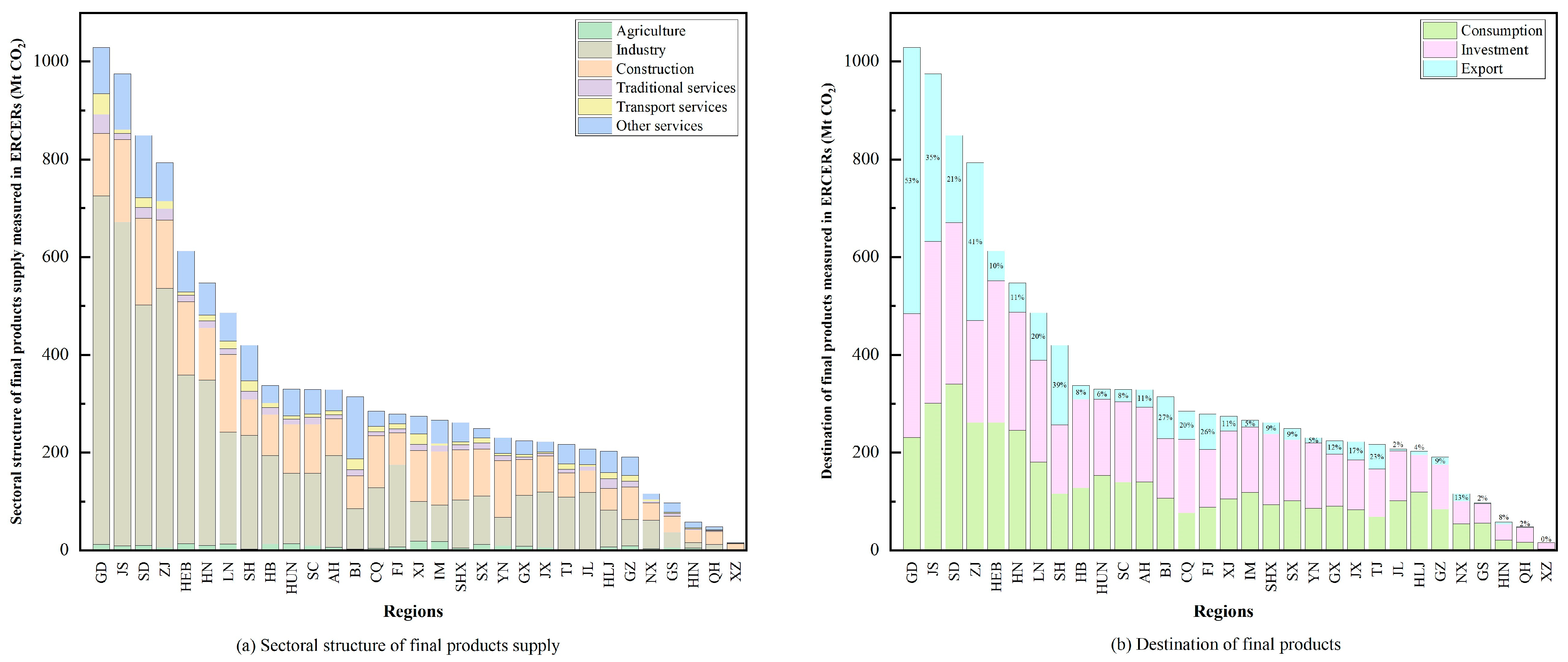
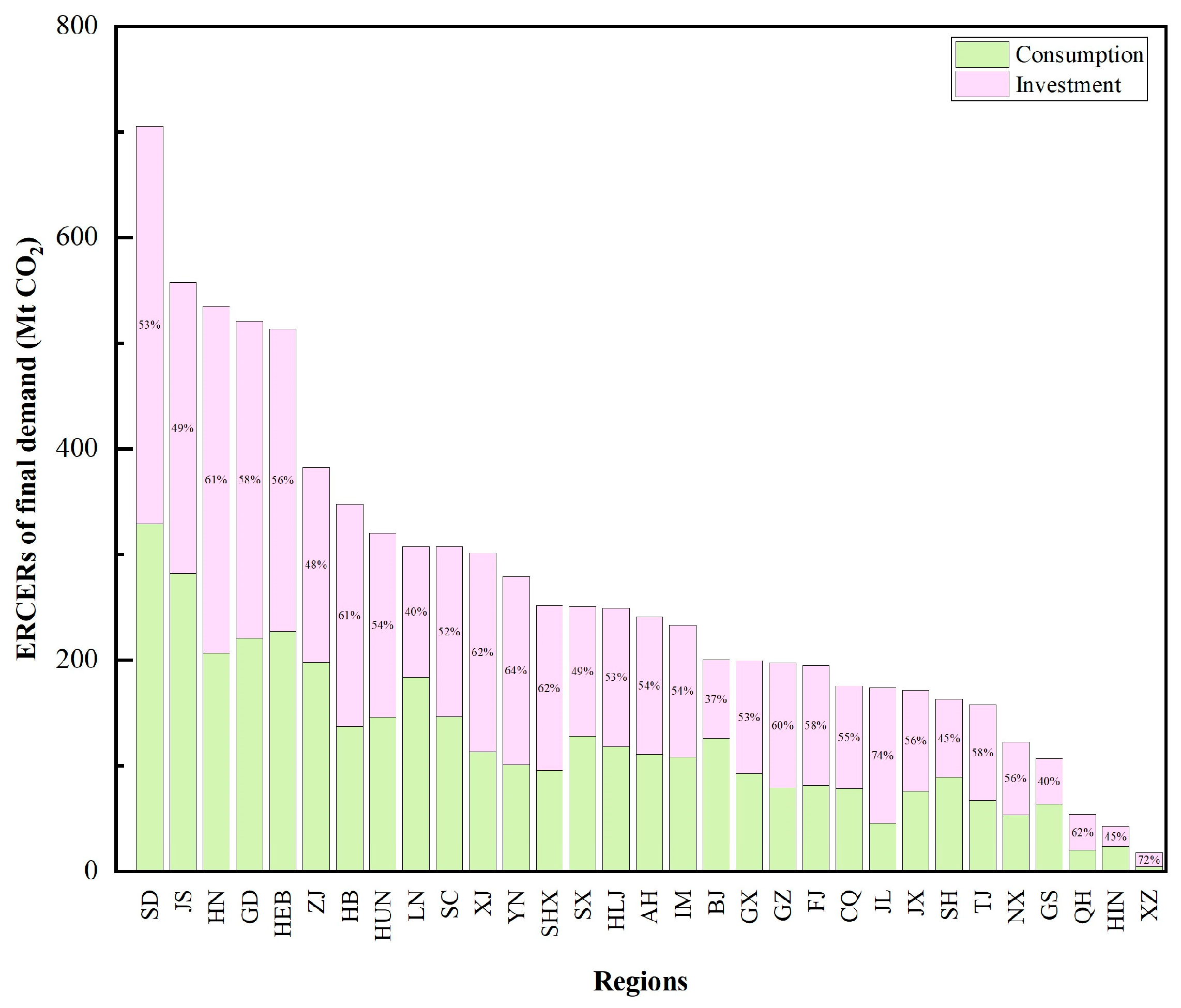
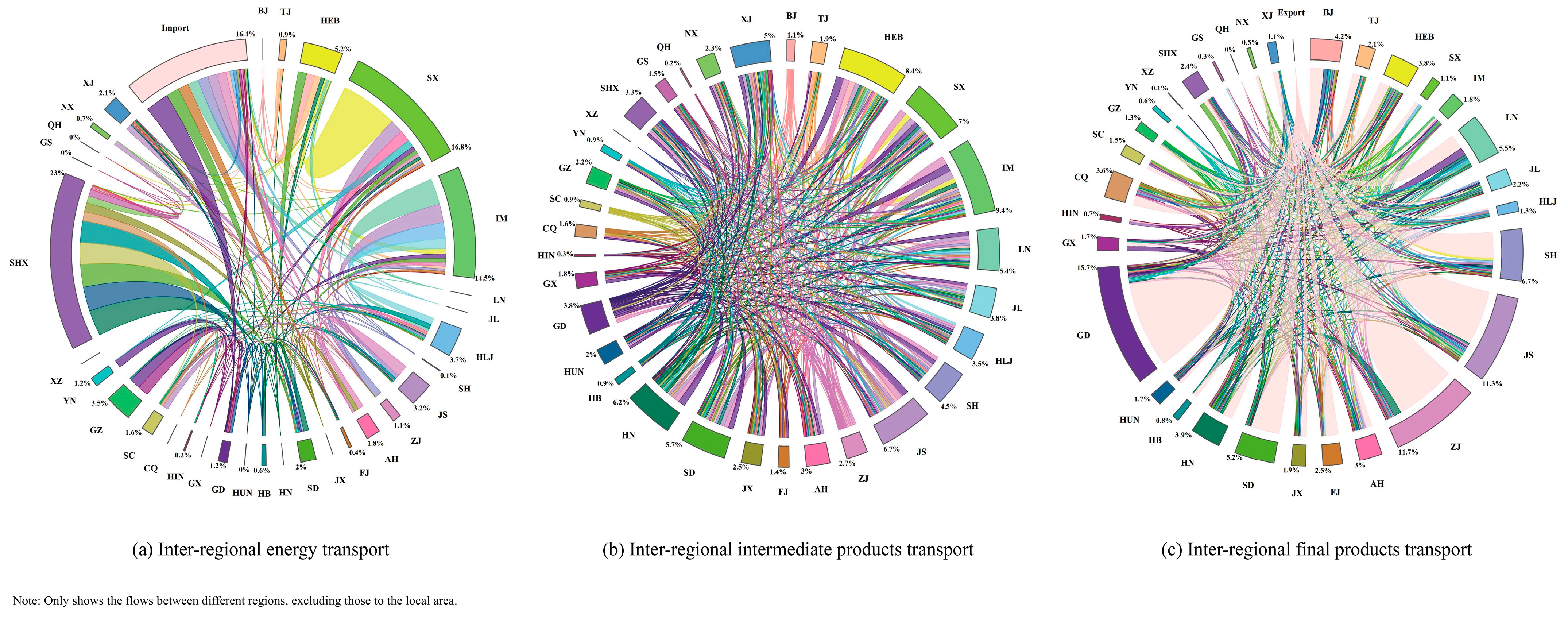
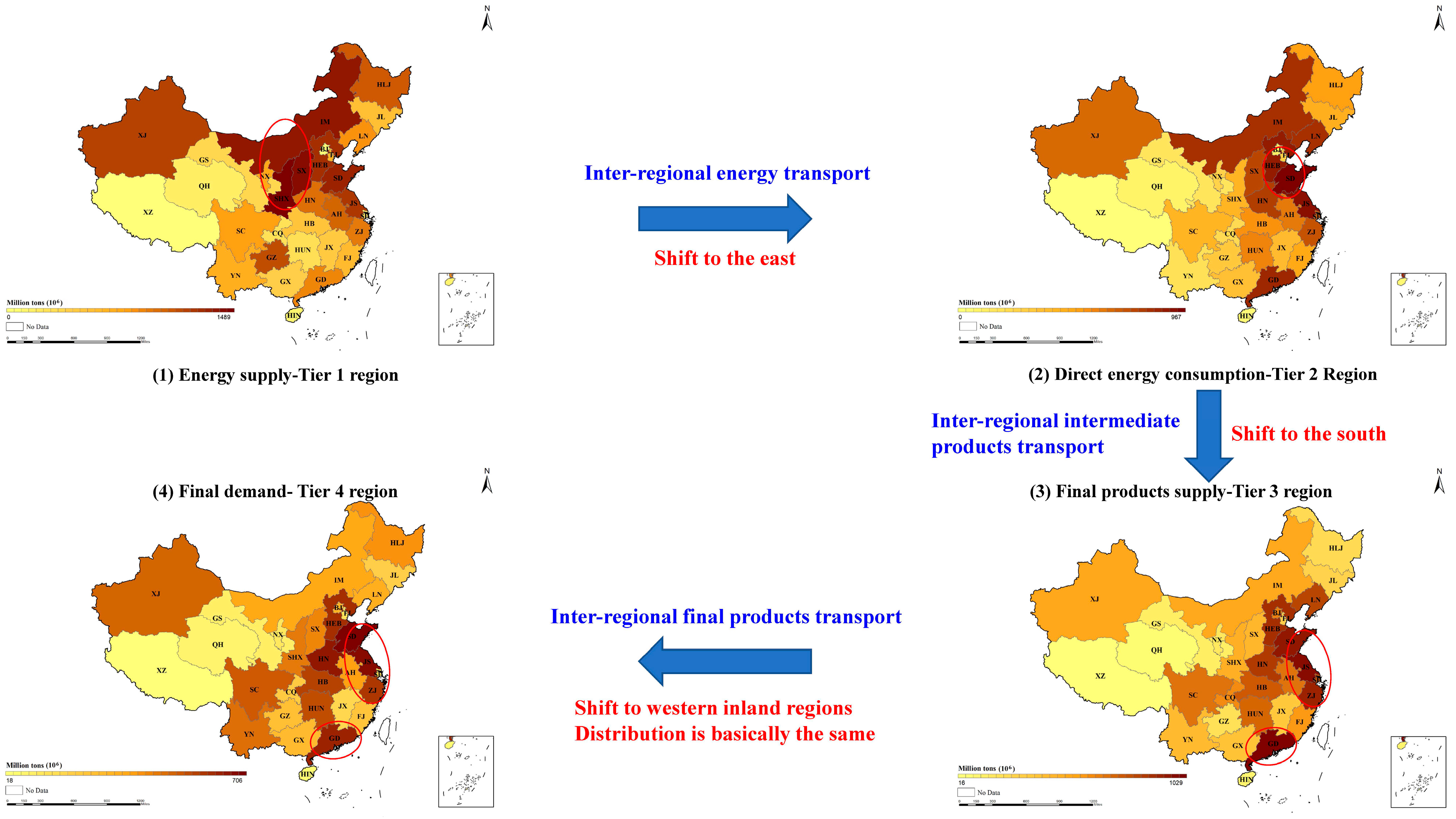
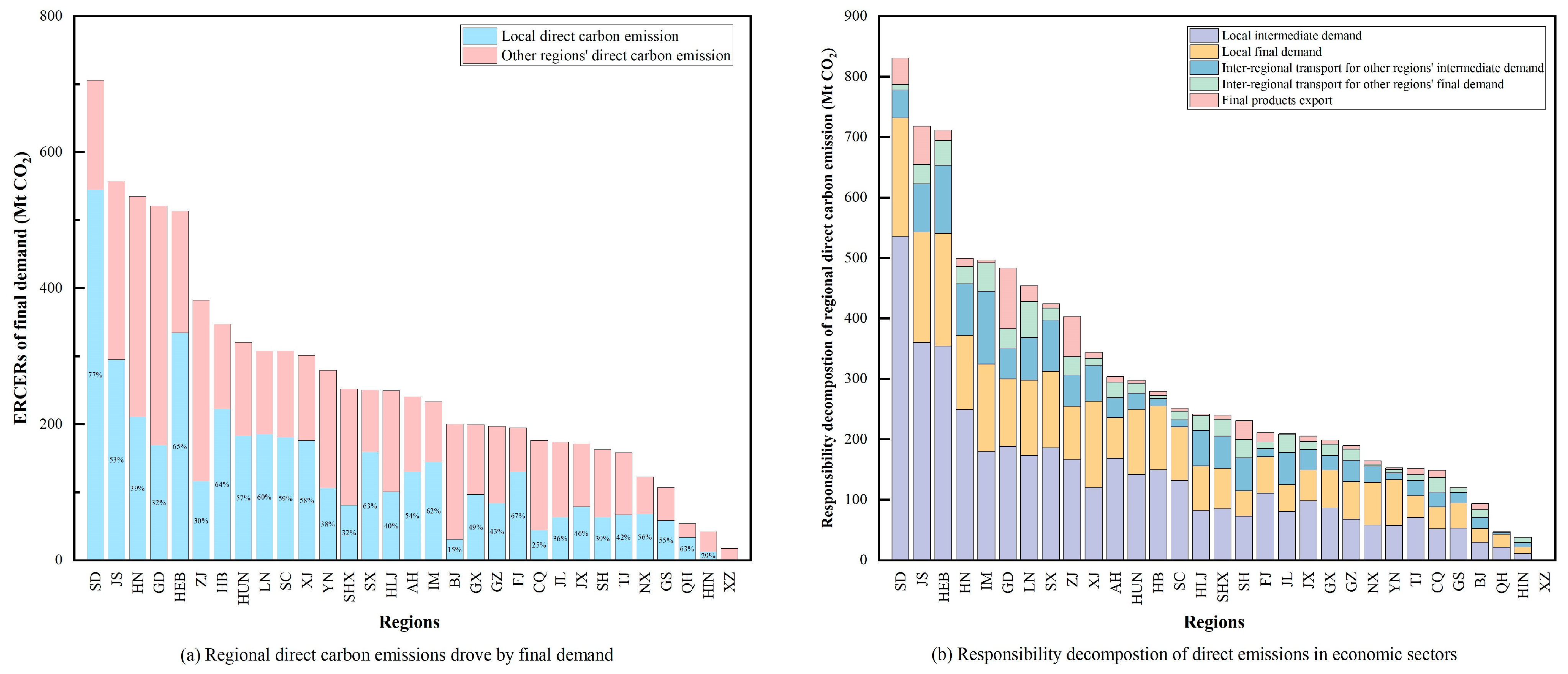
| Consumption Supply | Region 1 | Region 2 | Region m | Export |
|---|---|---|---|---|
| Region 1 | ||||
| Region 2 | ||||
| Region m | ||||
| Import |
| Energy Variety | Coal | Oil | Natural Gas |
|---|---|---|---|
| CO2 emissions factor | 2.66 | 1.73 | 1.56 |
| Category | Region | Energy Transport | Intermediate Products Transport | Final Products Transport | Characteristics |
|---|---|---|---|---|---|
| 1 | HB | + | + | + | All three links exhibit a net inflow of ERCERs |
| GD | + | + | + | ||
| YN | + | + | + | ||
| 2 | TJ | + | + | Both energy and economic products transport exhibit a net inflow of ERCERs | |
| ZJ | + | + | |||
| SC | + | + | |||
| HN | + | + | |||
| QH | + | + | |||
| 3 | BJ | + | + | − | Energy transport represents a net inflow of ERCERs, whereas economic products transport involves both net inflows and outflows of ERCERs |
| JS | + | + | − | ||
| HIN | + | + | − | ||
| CQ | + | + | − | ||
| GS | + | − | + | ||
| NX | + | − | + | ||
| 4 | FJ | + | Energy transport exhibits a net inflow of ERCERs, whereas economic products transport shows a balance | ||
| JX | + | ||||
| HUN | + | ||||
| GX | + | ||||
| 5 | HEB | + | − | Energy transport exhibits a net inflow of ERCERs, whereas economic products transport shows a net outflow of ERCERs | |
| SD | + | − | |||
| SH | + | − | |||
| AH | + | − | |||
| LN | + | − | − | ||
| JL | + | − | − | ||
| 6 | HLJ | − | + | Energy is basically self-sufficient | |
| XZ | + | + | |||
| 7 | GZ | − | + | Energy transport exhibits a net outflow of ERCERs; intermediate products transport tends to involve an outflow of ERCERs, whereas final products transport tends to involve an inflow | |
| SHX | − | ||||
| SX | − | − | + | ||
| XJ | − | − | + | ||
| IM | − | − |
Disclaimer/Publisher’s Note: The statements, opinions and data contained in all publications are solely those of the individual author(s) and contributor(s) and not of MDPI and/or the editor(s). MDPI and/or the editor(s) disclaim responsibility for any injury to people or property resulting from any ideas, methods, instructions or products referred to in the content. |
© 2025 by the authors. Licensee MDPI, Basel, Switzerland. This article is an open access article distributed under the terms and conditions of the Creative Commons Attribution (CC BY) license (https://creativecommons.org/licenses/by/4.0/).
Share and Cite
Yuan, Y.; Zhao, Y.; Yang, H.; Chong, C.H.; Ma, L.; Chang, S.; Li, Z. Mapping the Transmission of Carbon Emission Responsibility Among Multiple Regions from the Perspective of the Energy Supply Chain: EA-MRIO Method and a Case Study of China. Sustainability 2025, 17, 8166. https://doi.org/10.3390/su17188166
Yuan Y, Zhao Y, Yang H, Chong CH, Ma L, Chang S, Li Z. Mapping the Transmission of Carbon Emission Responsibility Among Multiple Regions from the Perspective of the Energy Supply Chain: EA-MRIO Method and a Case Study of China. Sustainability. 2025; 17(18):8166. https://doi.org/10.3390/su17188166
Chicago/Turabian StyleYuan, Yuan, Yunlong Zhao, Honghua Yang, Chin Hao Chong, Linwei Ma, Shiyan Chang, and Zheng Li. 2025. "Mapping the Transmission of Carbon Emission Responsibility Among Multiple Regions from the Perspective of the Energy Supply Chain: EA-MRIO Method and a Case Study of China" Sustainability 17, no. 18: 8166. https://doi.org/10.3390/su17188166
APA StyleYuan, Y., Zhao, Y., Yang, H., Chong, C. H., Ma, L., Chang, S., & Li, Z. (2025). Mapping the Transmission of Carbon Emission Responsibility Among Multiple Regions from the Perspective of the Energy Supply Chain: EA-MRIO Method and a Case Study of China. Sustainability, 17(18), 8166. https://doi.org/10.3390/su17188166








